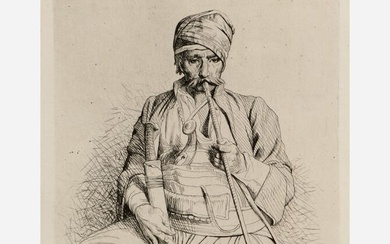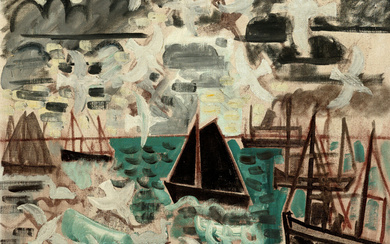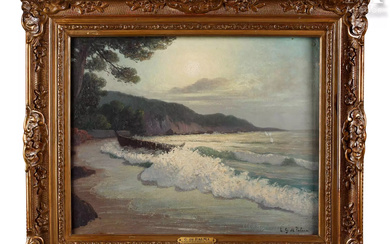Jean-Léon Gérôme (French, 1824-1904): A rare bronze equestrian figure of 'Napoleon Entering Cairo (Bonaparte entrant au Caire)
Conceived 1897, the present cast produced prior to 1904,
Conceived 1897, the present cast produced prior to 1904,
The figure of Napoleon holding his plumed bicorne in his right hand and seated on an elaborate richly decorated saddle, the naturalistic base cast with multiple leaves signed J.L. Gérôme and with SIOT FONDEUR PARIS foundry mark, numbered 10, the bronze with gilt and iron red and green patination, the whole mounted on a gilt bronze mounted green veined marble rectangular plinth base with swept moulded top and stepped base, the front with an applied winged scarab above an anthemion border, the figure, 56cm high, 49cm wide, 22cm deep, the plinth, 23cm high, 61cm wide, 26cm deep (2)
Literature:
Gerald M. Ackerman, The Life and Work of Jean Leon Gerome, ACR Edition, Paris: 1986, (p.150, illustrated pp. 322-323).
Jane Thompson & David H.T. Scott, The East: Imagined, Experience, Remembered: Orientalist Nineteenth Century Painting, National Gallery of Ireland, 1988 (p.89).
Jean-Loup Champiòn & Charles Janoray, A Golden Age of French Sculpture 1850- 1900 ,exhibition catalogue, Charles Lanoray, 2003 (p. 38).
Peter Fusco & H. W. Janson, The Romantics to Rodin, New York, 1980, (pp. 285-292).
Stanislas Lami, Dictionnaire des Sculpteurs de l'Ecole Francaise, Paris, 1970, (pp. 54-57).
Although Jean-Léon Gérôme is arguably one of the most influential French artists of the 19th century renowned for his Orientalist paintings he didn't take up sculpture until much later in his life.
Initially studying with the painter, Paul Delaroche, who became Gérôme's most influential teacher in Paris and then in Italy, his career was defined by his extensive travelling. Encounters in Northern Africa and the Near East were especially influential in the development of his oeuvre and artistic language. Throughout his career, the exotic subjects of foreign cultures, their individual connotations with ancient history, as well as their unique architecture and fashions left an indelible mark on his mind. Developing a recognizable technique based on Orientalist themes within the Neo-Greco style, his debut at the Paris Salon caused a sensation with 'The Cockfight' (1846), which won him a third-class medal. The painting was subsequently purchased by the French state and is now in the permanent collection of the Museum d'Orsay.
In 1863, Gérôme was appointed professor of the Ecole des Beaux-Arts. In that same pivotal year he married the daughter of the prominent Parisian art dealer and publisher, Jean Goupil. His unique talent and these elevated professional and personal positions in the art word uniquely and unusually for the time influenced other contemporary artists who chose his subjects as inspiration for their owns works during his lifetime, such as Étienne Henri Dumaige's 'Cleopatra and Apollodorus' in 1866 and Joseph Falguière's 'Phryne' in 1870. In 1874 his already highly successful career was further honoured when he received a gold medal at the International Exhibition and was created an Officer of the Legion of Honour.
However it was from the 1870s onwards that Gérôme devoted himself to sculpture. derived from a fascination of the human body. Sensing the growing popularity of smaller scale bronzes and marble figures and feeling that his prolific career in painting had become a little repetitive, he exhibited his first work entitled 'Two Gladiators' in 1878 at the Salon when he was 54 years old.
Innovation was a key factor in influencing his sculptural style and his works would often combine ivory, marble and gilt alongside silvered or patinated bronze. Two of his most accomplished sculptures 'Tanagra' from 1890 and 'Corinth' from 1904 show great accomplishment even though they date to the last fourteen years of his career.
The present lot depicts the young Napoleon entering Cairo and was conceived in the last decade of Gérôme's career when he produced a series of equestrian statuettes of historical figures. The original model of Napoleon was first unveiled at the Salon in 1897 to a grand reception and was purchased by the French State for the then very substantial sum of 10,000 francs. It then entered into the collection of the Galerie de Luxembourg.
Napoleon's Egyptian campaign of 1798-1801 became a huge source of pride for France due not only to its victorious result but also because of the harsh conditions which were endured by the French soldiers. The young and inexperienced Napoleon however proved himself a supremely talented commander, leading the French army by example through unorthodox fighting and starvation in the unforgiving desert. Accepting the same punishing conditions and rations as his troops, it was a major milestone for the 29-year-old Napoleon. His victorious entry in Cairo depicting in the bronze established Napoleon's position in the new French State and was instrumental in his eventual rise to the sole ruler of the new French Empire.
At the time Gérôme's work was conceived in 1897, it marked nearly one hundred years since the anniversary of Napoleon's victorious entry into Cairo. As such Gérôme took great care to depict Napoleon in his finery with his cape, bicorne hat and long bound hair. The allusion to the exotic campaign of Napoleon are suggested with the horse's saddle, bridle and tack all detailed with Middle Eastern style embroidery and tassels, as well as his two pistol holders on either the side of the saddle. However to counter this, Gerôme also depicted the leaders gaunt cheeks and thin and tired face to show the punishing physical evidence of starvation during the campaign.
The exacting details of the cast modelled by the Siot foundry illustrates the workshops competency and craftsmanship and this is shown in Napoleon's elaborate costume and his accoutrements and accessories. Added to this, the present cast is a rare and exceptional one because it unusually still retains the original patinated colouring of the leaves on the base and tinting of the horse's saddle and other tack. The use of colour to enhance the sculptures was ground-breaking at the time and demonstrates both Gérôme's and the Siot foundries dedication to experimentation.
Other edition casts of 'Napoleon Entering Cairo on Horseback' can be found in the Musée d'Orsay in Paris, the Musée Chateauroux and the Musée Garret in Vesoul, as well as in the Harding Museum in Chicago, USA.
View it on
Sale price
Estimate
Time, Location
Auction House
Conceived 1897, the present cast produced prior to 1904,
Conceived 1897, the present cast produced prior to 1904,
The figure of Napoleon holding his plumed bicorne in his right hand and seated on an elaborate richly decorated saddle, the naturalistic base cast with multiple leaves signed J.L. Gérôme and with SIOT FONDEUR PARIS foundry mark, numbered 10, the bronze with gilt and iron red and green patination, the whole mounted on a gilt bronze mounted green veined marble rectangular plinth base with swept moulded top and stepped base, the front with an applied winged scarab above an anthemion border, the figure, 56cm high, 49cm wide, 22cm deep, the plinth, 23cm high, 61cm wide, 26cm deep (2)
Literature:
Gerald M. Ackerman, The Life and Work of Jean Leon Gerome, ACR Edition, Paris: 1986, (p.150, illustrated pp. 322-323).
Jane Thompson & David H.T. Scott, The East: Imagined, Experience, Remembered: Orientalist Nineteenth Century Painting, National Gallery of Ireland, 1988 (p.89).
Jean-Loup Champiòn & Charles Janoray, A Golden Age of French Sculpture 1850- 1900 ,exhibition catalogue, Charles Lanoray, 2003 (p. 38).
Peter Fusco & H. W. Janson, The Romantics to Rodin, New York, 1980, (pp. 285-292).
Stanislas Lami, Dictionnaire des Sculpteurs de l'Ecole Francaise, Paris, 1970, (pp. 54-57).
Although Jean-Léon Gérôme is arguably one of the most influential French artists of the 19th century renowned for his Orientalist paintings he didn't take up sculpture until much later in his life.
Initially studying with the painter, Paul Delaroche, who became Gérôme's most influential teacher in Paris and then in Italy, his career was defined by his extensive travelling. Encounters in Northern Africa and the Near East were especially influential in the development of his oeuvre and artistic language. Throughout his career, the exotic subjects of foreign cultures, their individual connotations with ancient history, as well as their unique architecture and fashions left an indelible mark on his mind. Developing a recognizable technique based on Orientalist themes within the Neo-Greco style, his debut at the Paris Salon caused a sensation with 'The Cockfight' (1846), which won him a third-class medal. The painting was subsequently purchased by the French state and is now in the permanent collection of the Museum d'Orsay.
In 1863, Gérôme was appointed professor of the Ecole des Beaux-Arts. In that same pivotal year he married the daughter of the prominent Parisian art dealer and publisher, Jean Goupil. His unique talent and these elevated professional and personal positions in the art word uniquely and unusually for the time influenced other contemporary artists who chose his subjects as inspiration for their owns works during his lifetime, such as Étienne Henri Dumaige's 'Cleopatra and Apollodorus' in 1866 and Joseph Falguière's 'Phryne' in 1870. In 1874 his already highly successful career was further honoured when he received a gold medal at the International Exhibition and was created an Officer of the Legion of Honour.
However it was from the 1870s onwards that Gérôme devoted himself to sculpture. derived from a fascination of the human body. Sensing the growing popularity of smaller scale bronzes and marble figures and feeling that his prolific career in painting had become a little repetitive, he exhibited his first work entitled 'Two Gladiators' in 1878 at the Salon when he was 54 years old.
Innovation was a key factor in influencing his sculptural style and his works would often combine ivory, marble and gilt alongside silvered or patinated bronze. Two of his most accomplished sculptures 'Tanagra' from 1890 and 'Corinth' from 1904 show great accomplishment even though they date to the last fourteen years of his career.
The present lot depicts the young Napoleon entering Cairo and was conceived in the last decade of Gérôme's career when he produced a series of equestrian statuettes of historical figures. The original model of Napoleon was first unveiled at the Salon in 1897 to a grand reception and was purchased by the French State for the then very substantial sum of 10,000 francs. It then entered into the collection of the Galerie de Luxembourg.
Napoleon's Egyptian campaign of 1798-1801 became a huge source of pride for France due not only to its victorious result but also because of the harsh conditions which were endured by the French soldiers. The young and inexperienced Napoleon however proved himself a supremely talented commander, leading the French army by example through unorthodox fighting and starvation in the unforgiving desert. Accepting the same punishing conditions and rations as his troops, it was a major milestone for the 29-year-old Napoleon. His victorious entry in Cairo depicting in the bronze established Napoleon's position in the new French State and was instrumental in his eventual rise to the sole ruler of the new French Empire.
At the time Gérôme's work was conceived in 1897, it marked nearly one hundred years since the anniversary of Napoleon's victorious entry into Cairo. As such Gérôme took great care to depict Napoleon in his finery with his cape, bicorne hat and long bound hair. The allusion to the exotic campaign of Napoleon are suggested with the horse's saddle, bridle and tack all detailed with Middle Eastern style embroidery and tassels, as well as his two pistol holders on either the side of the saddle. However to counter this, Gerôme also depicted the leaders gaunt cheeks and thin and tired face to show the punishing physical evidence of starvation during the campaign.
The exacting details of the cast modelled by the Siot foundry illustrates the workshops competency and craftsmanship and this is shown in Napoleon's elaborate costume and his accoutrements and accessories. Added to this, the present cast is a rare and exceptional one because it unusually still retains the original patinated colouring of the leaves on the base and tinting of the horse's saddle and other tack. The use of colour to enhance the sculptures was ground-breaking at the time and demonstrates both Gérôme's and the Siot foundries dedication to experimentation.
Other edition casts of 'Napoleon Entering Cairo on Horseback' can be found in the Musée d'Orsay in Paris, the Musée Chateauroux and the Musée Garret in Vesoul, as well as in the Harding Museum in Chicago, USA.







